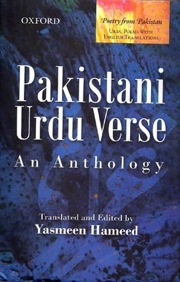‘Here is a garden:
the wind moves, buds sprout, fill up with scent,
flowers bloom, then wilt and perish,
make a velvety floor;
my dreams, desires, these fairies,
on the floor they glide
as if the garden itself is the mirror:
each face, each form it brightens,
beautifies, then perishes, never to revive.’
(Meeraji, To the Ocean Must All Return)
Translated and edited by well known Urdu poet Yasmeen Hameed, Pakistani Urdu Verse, An Anthology, moves away from the works of the traditional poets who form the Urdu canon. It seeks to give a wider audience to poets writing from the nineteen forties onwards. This also means that it focuses on the use of a different verse form: rather than the ghazal, the poems published here are in the nazm form, making this genre the defining principle of the book. As Ms. Hameed explains in her introduction, Tasadduq Husain Khalid (whose verse is not included here), Noon Meem Rashed and Meeraji were pioneers of free verse. ‘A nazm has a title as it has a particular theme and is unified through continuity of meaning. Change in the traditional form of the nazm began with the introduction of the blank verse (nazm-i-muarra) in the late nineteenth century… (while) free verse (azad nazm) was introduced in the early twentieth century. This latter is now the most popular form of the nazm. ‘
The collection, put together with great sensitivity and much labour, grew out of the poet’s own initiative, with the regular publication of selections of her choice in the original as well as in translation. These appeared in the Books and Authors section of the English newspaper Dawn which I remember reading several years ago. This is itself was a departure. With this volume, an entire new genre of verse and a wide group of poets are represented and made accessible to a generation of Pakistanis for whom Urdu has become a remote language, often learned as an optional, second language in English medium schools. This means that although children going to English medium schools grow up speaking their regional language or basic Urdu, they frequently lack a connection with the language and thereby the culture that it represents. This book is a step in bridging that gap. It features the work of over sixty modern poets who wrote/write in the above mentioned poetic form, including the nasri nazam, (prose poem). Although she recognises the continuing popularity of the older ghazal form, her personal affinity appears to be the nazm, whose more informal structure encompasses modern and post modern thought.
The comprehensive introduction gives background in the history of Urdu as a language and as a vehicle for poetic expression. It also describes the development and recognition of the nazm and its several variations as an accepted poetic form, and an account of the poets who used and developed it. This journey has culminated in a rich plethora of voices. They include the lyrical, mellow voices of poets such as Faiz and Iftikhar Arif; the strong feminist voices of Kishwar Naheed and Fahmida Riaz (among other poets of that following) contrasting with the quieter yet determined voices of women like Zehra Nigah and Pareveen Shakir; poets of the Progressive Writers’ Movement founded in the nineteen thirties, and the emergence of the modernists. There are the introverted personal voices of writers such as Meeraji and Munir Niazi and the poetry of protest of Faiz, Faraz and Ahmed Nadeem Qasimi. The work of each poet is preceded by a short introduction, with insights into recurring themes and the time period to which they belonged.
Translation is a difficult art, and the finest and most well known translators often fail to achieve the music of the original. One of the reasons for this is differences in syntax, although this is only one element in a list of others. For instance there are cultural references which are not always easy to transpose or find the correct word for, and shades of diction. There are words which encompass several meanings in the original, for which it is virtually impossible to find a suitable match in the language it is being translated into. Poets who translate their own work have sometimes been faced with the dilemma of producing a literal translation or changing the structure of the lines to effect a more lyrical tone. Some of the best translations I have read are those in which the translator remains close to the essence, the meaning while ‘reinventing’ it by attempting to recreate the music.
Yasmeen Hameed humbly recognises the conflicts which face the translator; to be literal or lyrical, to attempt to conform to structure, to preserve the individuality of the poet when translating the work of several poets so that readers are able to recognise their particular style or voice? Her renderings vary, and are more successful in the case of some poets than of others. In this volume she follows a combination of rules in which she aims to recreate the essence of the poem while following (as far as possible) the original line breaks. In the case of some poems I feel that the insertion of commas to divide lines and phrases interferes with the flow. However, this is a matter of personal preference. For the most part she succeeds in bringing home the meaning and character of each work. Her compilation of almost a century’s work by a diverse group of poets is no mean feat. There is no doubt about it: this is a ground breaking collection encompassing the brief and bittersweet poetic history of the nation.






